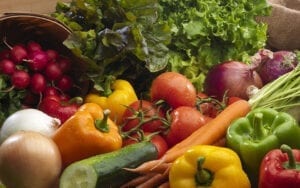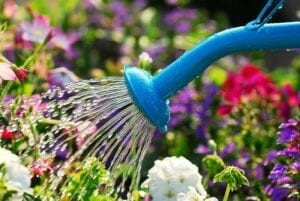Get the most out of your vegetable garden by following these tips:
Location
Vegetable gardens should be located in full sun; avoid areas that are shaded by trees, buildings or other structures. The soil should drain well and not puddle for any length of time.
When to Plant
In general, vegetables are divided into two major groups that determine when they are to be planted, cool-season and warm-season.
 Cool-season vegetables prefer and do best in daytime temperatures that are around 60-65 degrees F. and will tolerate some light frost. Cool-season vegetables are planted outdoors in the garden beginning in late March through early May and are harvested in late June through July before the heat of the summer. For a fall harvest, a second planting of cool-season vegetables can be planted between early June and mid-August for harvest in late October through November or later.
Cool-season vegetables prefer and do best in daytime temperatures that are around 60-65 degrees F. and will tolerate some light frost. Cool-season vegetables are planted outdoors in the garden beginning in late March through early May and are harvested in late June through July before the heat of the summer. For a fall harvest, a second planting of cool-season vegetables can be planted between early June and mid-August for harvest in late October through November or later.
Cool-season vegetables include: Beets, broccoli, cabbage, carrots, cauliflower, collards, kale, leeks, lettuce, onions, peas, radishes and spinach to name a few.
 Warm-season vegetables like temperatures that are 65-80 degrees F. and will not tolerate a frost. The last frost date in our area is usually around early May, so most of these vegetables cannot be safely planted outdoors until after May 15th.
Warm-season vegetables like temperatures that are 65-80 degrees F. and will not tolerate a frost. The last frost date in our area is usually around early May, so most of these vegetables cannot be safely planted outdoors until after May 15th.
Warm Season vegetables include: Beans, cantaloupe, cucumbers, eggplant, okra, peppers, pumpkin, squash, sweet corn, tomatoes, watermelon and zucchini.
Preparing the Soil
Good soil preparation before planting will guarantee healthy vegetable plants and higher yields at harvest time. Mix in a soil amendment with a high organic content such as Dr. Earth Vegetable Garden Planting Mix or compost into the soil.
Planting Vegetables
It is very important to follow the spacing guidelines on the seed pack or plant label for each type of vegetable. This ensures your plants have the room they need to grow and produce fruit. Plants like tomatoes, peppers and eggplant may require the extra support of a tomato cage or stakes.
Fertilizer
Remember, you are what you eat, so choosing an organic fertilizer for your vegetable garden is a must. One of our favorites is Espoma Garden-tone®, which is an all-natural, organic, slow release, continuous feeding fertilizer. Apply once a month May through August for optimum results.
 Watering
Watering
Water vegetable gardens only when the soil is dry and needs it. Deep, but infrequent, watering, two or three times a week is best if there is no natural rainfall. Excessive watering may encourage insect and disease problems.
Mulch
Use a mulch to prevent weeds, conserve water and cool soil temperatures.
Pest & Disease Control
Before using pesticides in the vegetable garden, identify the pest and select the least-toxic control for the problem. If you’re not sure about a particular problem or its solution, bring in a sample to Hicks Nurseries in a sealed plastic bag. We are always available to help identify the pest/disease and recommend a remedy.
Fresh-picked vegetables from your own garden are tastier and more nutritious than store-bought vegetables. And, vegetables really grow themselves – all you have to do is help them out a little so they can be their best.
